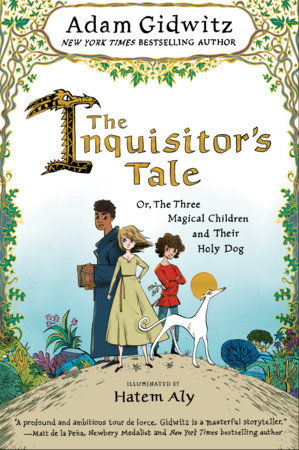 The Inquisitor's Tale
The Inquisitor's TaleAdam Gidwitz
Dutton, 2016 337 pgs
Grades 5-8
Fantasy
Multiple
narrators, hanging-out at a tavern, tell the tale of three children and a dog
who possess magical and, perhaps, Godly powers in medieval France. Jeanne is a
peasant girl who goes into trances where she predicts the future. Her dog,
Gwenforte, died protecting Jeanne as a baby, only to return from the dead to
protect her from prosecution as a heretic. William, a boy of mixed race and
social stature, is currently studying to be a monk. He possesses superhuman
strength and is of a size not to be surpassed by most common folk. Finally,
Jacob is granted the power of healing. His whole village is burnt to the
ground, including his parents, only because they are Jewish. The three children
find each other, become friends, and travel together seeking sanctuary. Along
the way they meet King Louis of France, thought to be a loving King, yet
passionately against the Jewish religion and disrespectful to peasants. Louis
and his powerful mother demand that all existing hand-copied volumes of the
Talmud be destroyed. The children, along with a determined Monk who was thought
to be an enemy, but turns out to be an ally, are committed to saving the sacred
texts. But how? The action changes from tales at the inn told to an inquisitor
to the same inquisitor joining the children and becoming part of actual story.
What follows is a magical and thrilling climax gathering all of the scattered
plot threads and characters, demonstrating that the good can overcome evil and
that the long arm of God can produce miracles.
Told much in the style of a tale shared by a medieval minstrel, Gidwitz shows the reader that the middle ages were anything but boring. Following the format of The Canterbury Tales different narrators from different walks of life contribute the part of the children's accounts that they witnessed. Most of the story is told orally, placing the reader squarely in the time and place. Gidwitz keeps the narration distinct and manages to accurately, clearly, and effectively maintain all of the different voices. Although there are supernatural elements in this book and some fantastic beasts, such as dragons, it is not the stuff of high fantasy. All of the magic therein are happenings that would have been believable to folks during this time period and are recorded in legend and song. Illustrations, contributed by Hatem Aly, are beautiful and reflect the manuscripts of the time. Although possessing a medieval mood, they are also cartoon-ish in style, encouraging young readers to jump into this book and keep turning pages. I have often had readers over the years ask me for books about knights that aren't fantasy. This would be a perfect choice for such a reader. The story contains action, some gore and gross bits, and relatable characters. Beyond this, there is much substance, history, and a well-written text. Gidwitz clearly did his research and offers an author's note at the back of the book describing his path to authorship of such an unusual book for children and clarifying what is fact and what is fiction within the text. The factual parts will surprise the reader and made me almost want to read it again. It’s very strange that two of my favorite books this year are set in medieval France and deal with religious topics and heresy (The Passion of Dolssa by Berry), especially since before this year I have NEVER seen a children's or teen book on the subject. At any rate, this is a well-crafted book for a special and thoughtful reader.
No comments:
Post a Comment